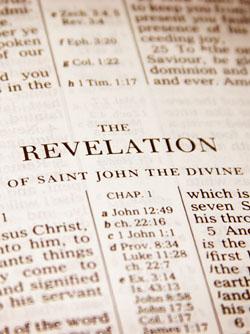The Mysterious First Horseman!
Nearly everyone wants to know what the future holds, yet it is widely believed that no one can accurately predict the future. The God of the Bible, however, boldly states: "I am God, and there is none like Me.
Nearly everyone wants to know what the future holds, yet it is widely believed that no one can accurately predict the future. The God of the Bible, however, boldly states: "I am God, and there is none like Me. I make known the end from the beginning, from ancient times, what is still to come. What I have said, that I will bring about" (Isaiah 46:9–11, NIV). Bible prophecies about the mysterious First Horseman of the Apocalypse provide important insights into history, and reveal where current events are heading. The Bible's "ancient" prophecies are coming alive today, and will surprise a world that has lost sight of the real God of the Bible.
Almost 2,000 years ago, Jesus Christ told His disciples that He would come again at the end of the age (Matthew 24:3, 30–31; John 14:3; Acts 1:11). He explained that a series of recognizable events—false prophets and religious deception, wars and rumors of wars, famines and natural calamities (e.g. earthquakes and disease epidemics)—would precede His Second Coming (Matthew 24:3–8; Mark 13:5–8; Luke 21:8–11). The sequence of these events is important. Jesus warned His disciples to watch for these signs, because an unsuspecting world will be surprised by swiftly escalating events in the last days (Matthew 24:36–44; Mark 13:32–36; Luke 21:34–36).
The Apostle Paul warned that false teachers would come, preaching another Jesus and a different gospel (2 Corinthians 11:1–4).
The Mysterious Rider
Bible students recognize that the Four Horsemen of the Apocalypse are symbolic of end-time events preceding Christ's return. Yet controversy exists over the identity of the first horseman, who rides a white horse. Some say that the rider represents Jesus Christ preaching the Gospel, because of his apparent similarity to Christ on a white horse, as described in Revelation 19:11–14. Others believe that the first horseman represents the antichrist, who will oppose Christ at His return. Many view the Four Horsemen as a mere allegory—a device that only conveys a spiritual lesson and is not related to real-life events.
The Bible, of course, provides its own explanation. The sequence of end-time events outlined in Matthew, Mark and Luke parallels the events pictured by the Four Horsemen of Revelation 6. In each of the Gospels, the initial event of the end-time sequence is a growing prevalence of false teachers and religious deception. This means that the first horseman is not Jesus Christ, but instead personifies a great false religious movement. The crown of this rider (a symbol of leadership and authority) suggests a prominent religious leader (Revelation 6:2). He carries a bow (for shooting arrows), in contrast to Christ in Revelation 19:11–15, who is pictured with a sword and a rod of iron. Ephesians 6:16 pictures Satan shooting darts (arrows) at true Christians, thus suggesting that the first horseman is in league with Satan.
We should be sobered upon reading that the first horseman "went out conquering and to conquer" (Revelation 6:2). This points to the rise of a militant form of false Christianity just before Jesus Christ's return. This fits the end-time scenario that places the Great Tribulation—a time when true Christians will be persecuted—just after the events pictured by the Four Horsemen (see Matthew 24:8–9; Revelation 6:9–11). But how does the mysterious first horseman provide insights into history, explain the direction of current events and reveal the future?
History Reveals the Future
The Bible and Church history provide keys to the identity and future activity of the first horseman. The prophet Daniel speaks of a "little horn" associated with a Roman system that would "change times and law" (Daniel 7:21, 25). While the Bible reveals that Jesus, His disciples and the early Church kept the Sabbath and the biblical Holy Days (Luke 2:41–42; 4:16; Acts 17:2), history records that the Roman Church forbade observance of the biblical Passover and (at the Council of Nicea in 325ad) mandated the observance of Easter. The Roman Church also outlawed observance of the biblical Sabbath and (at the Council of Laodicea in 363ad) enshrined Sunday as its day of worship. The Roman Church adapted pagan celebrations of December 25 to commemorate Christ's birth, supposedly to make it easier for pagans to "convert" to Christianity. Through such changes, the teachings of the early Church were corrupted by paganism—thus fulfilling prophecies given by Daniel, Jesus and Paul.
Daniel prophesied that the "little horn" of the fourth empire (Rome) would preside over future revivals of that empire (Daniel 7:7–8, 24) and would "make war against the saints, and prevail against them" until Christ returns (Daniel 7:21–22, 25). These revivals link the "little horn" to the militant form of corrupt Christianity that will arise at the end of the age, and to a politically active church—the "great harlot" who rides the beast (composed of ten kings)—with whom worldly rulers have had intimate relations (Revelation 17). Church history leaves little doubt as to which institution has fulfilled this role.
The pontiffs of Rome presided over the revivals of the Roman Empire. During the Middle Ages, the papacy called for crusades to destroy enemies of that dominant church (see The Crusades, Hindley). Those "enemies" included not only Muslim "infidels," but also others who professed belief in Christ and the God of the Bible—including members of the Eastern Orthodox Church (a rival of Rome) who perished in the sack of Constantinople, many Jews, Sabbath-keeping Cathars and Albigensians in southern France and Waldensians in northern Italy and Germany. Those who followed the teachings of Jesus Christ, the Apostles and the early Church were labeled heretics, and slaughtered over the centuries, because they would not follow the decrees of the Church of Rome.
But how do these facts of history relate to current events and reveal the future? The "mainstream" Protestant churches took many of their doctrines and practices—including the idea of the Trinity, the immortal soul, and the observance of Christmas and Easter—from the teachings of the Roman Church. These pagan-inspired doctrines and practices are not found in the Bible, yet "mainstream" professing Christianity has adopted them, as the Bible predicted. The Roman Church is leading an "ecumenical" drive to bring all professing-Christian churches together under one umbrella, even though it has made clear that it considers itself the one true Church (see Isaiah 47:1–8). The Roman Church is promoting a united Europe, in which it can regain the prominent role it played in the "Holy Roman Empire." During the reign of the Holy Roman Emperors and other Catholic monarchs, the Roman Church used state power and the Inquisition to attack its "enemies" in the hope of creating one empire under one monarch and one religious leader. The history of medieval Europe sheds light on how a deceptive and militant false form of Christianity will operate when the first horseman of the Apocalypse begins his ride. We are watching these prophecies come alive today!






